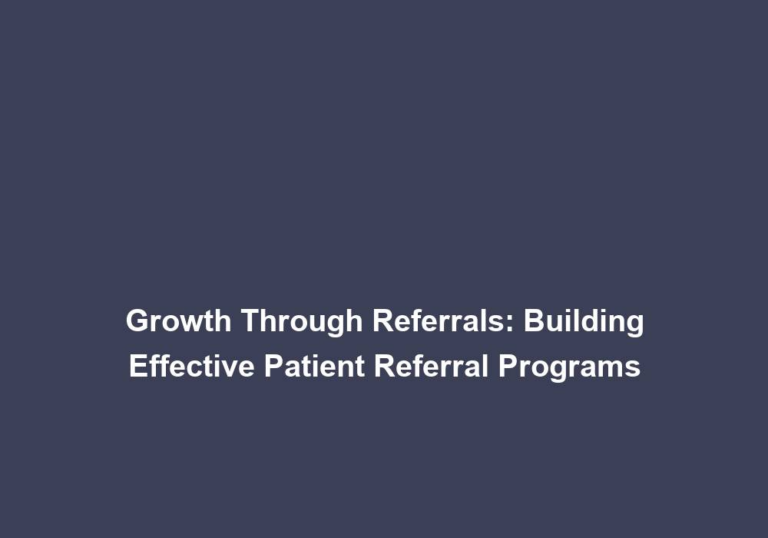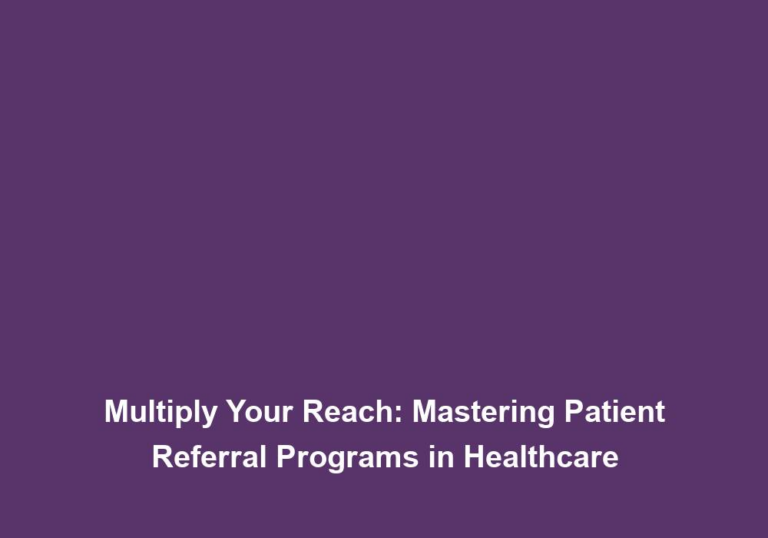Patient Power: Leveraging Referral Programs for Enhanced Healthcare Reach
In today’s digital age, patient power has become increasingly influential in the healthcare industry. Patients are now actively seeking information, researching healthcare providers, and making informed decisions about their own healthcare. In this context, referral programs have emerged as a powerful tool for healthcare providers to expand their reach and attract new patients. By leveraging referral programs effectively, healthcare organizations can tap into the vast potential of patient networks, boost their online presence, and ultimately improve patient outcomes.
Why Referral Programs Matter in Healthcare
Referral programs are not limited to retail businesses or e-commerce; they have immense value in the healthcare sector as well. In fact, studies have shown that patients are more likely to trust and choose a healthcare provider based on a recommendation from a friend, family member, or another trusted source. A well-executed referral program can significantly enhance a healthcare organization’s reputation and attract a larger patient base.
Building Trust and Credibility
Referral programs play a vital role in building trust and credibility. When patients recommend a healthcare provider to their friends and family, it creates a sense of trust and credibility around the recommended provider. Patients are more likely to trust the opinion of someone they know and value. By encouraging and incentivizing patients to refer others, healthcare providers can amplify their reputation and create a positive word-of-mouth effect.
Expanding on this, referral programs not only build trust and credibility, but they also strengthen the relationship between the healthcare provider and the patient. When a patient refers someone to a healthcare provider, they are essentially vouching for the quality of care they received. This personal endorsement can have a significant impact on potential patients who may be hesitant to try a new healthcare provider. By fostering a sense of trust and credibility, referral programs can attract new patients who are more likely to have a positive experience and continue seeking care from the referred provider.
Furthermore, when patients refer others, they are sharing their positive experiences with the healthcare provider. This positive word-of-mouth can have a ripple effect, reaching a larger audience and potentially attracting more patients. By continuously delivering high-quality care and encouraging patient referrals, healthcare organizations can build a strong reputation within the community and become the provider of choice for many individuals seeking healthcare services.
Expanding Reach and Patient Acquisition
Referral programs can be a powerful tool for healthcare providers to expand their reach and acquire new patients. By leveraging the existing patient network, healthcare organizations can tap into previously untapped markets and demographics. For example, a patient who refers a friend may introduce the provider to an entirely new group of potential patients. This ripple effect can significantly enhance the provider’s reach and visibility in the community.
Expanding on this, referral programs not only help healthcare providers attract new patients, but they also allow for targeted marketing efforts. When patients refer others, they are likely to share information about the healthcare provider’s services and specialties. This targeted marketing can help the provider reach individuals who may have specific healthcare needs that align with their expertise. By expanding their reach through referral programs, healthcare providers can connect with a diverse range of patients and offer tailored healthcare solutions.
Furthermore, referral programs provide an opportunity for healthcare providers to establish partnerships and collaborations with other professionals in the industry. By incentivizing referrals from other healthcare practitioners, providers can tap into their networks and gain access to a wider patient base. This collaborative approach not only benefits the provider but also enhances the overall quality of care delivered to patients by leveraging the expertise of multiple healthcare professionals.
Boosting Online Presence and SEO
In today’s digital world, having a strong online presence is essential for any healthcare provider. Referral programs can help boost a provider’s online presence and improve their search engine optimization (SEO) performance. When patients refer others, they often share their positive experiences on various online platforms, including social media, review websites, and online forums. These referrals and positive reviews can significantly impact a provider’s online reputation and visibility, making them more discoverable by potential patients.
Expanding on this, referral programs not only enhance a provider’s online presence but also contribute to their overall digital marketing strategy. By encouraging patients to share their experiences online, healthcare providers can generate user-generated content that showcases their expertise and patient satisfaction. This user-generated content, in the form of reviews, testimonials, and social media posts, can serve as powerful marketing tools that attract and influence potential patients.
Additionally, referral programs can help healthcare providers build a strong online community and engage with their patients on various digital platforms. By fostering a sense of community and encouraging patients to share their experiences online, providers can create a supportive environment where patients can interact, seek advice, and share valuable healthcare information. This engagement not only strengthens the provider-patient relationship but also establishes the healthcare provider as a trusted source of information and support within the online community.
Improving Patient Outcomes
Effective referral programs can ultimately lead to improved patient outcomes. When patients refer others to a healthcare provider, they are essentially vouching for the quality of care they received. By attracting more patients through referrals, healthcare providers can increase their patient volume and further invest in enhancing their services. This, in turn, creates a cycle of continual improvement and better patient outcomes.
Expanding on this, referral programs not only contribute to better patient outcomes through increased patient volume but also through the feedback and insights gained from the referred patients. When patients refer others, they are likely to share their experiences and provide valuable feedback to the healthcare provider. This feedback can help identify areas for improvement and drive quality enhancements in the delivery of care. By actively listening to the feedback received from referred patients, healthcare providers can make necessary adjustments and continually enhance their services, ultimately leading to better patient outcomes.
Furthermore, referral programs can facilitate coordinated care and seamless transitions between healthcare providers. When patients refer others, they are more likely to receive care from the same network of providers, leading to better care coordination and continuity. This continuity of care can significantly improve patient outcomes, particularly for individuals with complex healthcare needs who require ongoing collaboration between multiple healthcare professionals.
Building an Effective Referral Program
To leverage referral programs successfully, healthcare providers need to develop a well-structured and comprehensive approach. Here are some key strategies to consider:
1. Clearly Define Objectives
Before implementing a referral program, it is essential to define clear objectives. Determine what you hope to achieve through the program, such as increasing patient volume, expanding into new markets, or improving patient satisfaction. By setting specific goals, healthcare providers can design a program that aligns with their overall strategic objectives.
Expanding on this, clearly defining objectives allows healthcare providers to tailor their referral program to meet specific needs and priorities. For example, if the objective is to increase patient volume, the referral program can focus on incentivizing referrals from existing patients. On the other hand, if the objective is to expand into new markets, the referral program can target referrals from other healthcare practitioners or community organizations. By aligning the program with specific objectives, healthcare providers can maximize the impact of their referral efforts and achieve measurable results.
2. Incentivize Referrals
Offering incentives can be a powerful motivator for patients to refer others. Consider providing rewards such as discounts on services, gift cards, or even exclusive access to certain healthcare programs. The value of the incentive should be significant enough to encourage referrals without compromising the provider’s financial sustainability.
Expanding on this, incentives not only encourage patients to refer others but also reinforce the value and importance of their referrals. By offering meaningful incentives, healthcare providers show appreciation for the trust and confidence patients place in their services. This appreciation can strengthen the provider-patient relationship and encourage continued loyalty and advocacy.
Furthermore, incentives can be tailored to specific patient preferences and interests. For example, if the target patient demographic is young adults, the referral program can offer incentives that align with their preferences, such as discounts on fitness classes or wellness products. By personalizing the incentives, healthcare providers can make the referral program more appealing and increase the likelihood of patient participation.
3. Streamline the Referral Process
Make it easy for patients to refer others by streamlining the referral process. Provide clear instructions and multiple referral channels, including online forms, email, and phone. Additionally, ensure that the referral process is seamless for both the referring patient and the referred individual. A complicated or lengthy process may discourage potential referrals.
Expanding on this, a streamlined referral process not only increases convenience for patients but also improves the overall patient experience. By providing clear instructions and user-friendly referral channels, healthcare providers can remove barriers and make the referral process effortless. This simplicity encourages patients to refer others, as they can easily share information and complete the referral without any hassle.
Furthermore, a streamlined referral process allows for efficient tracking and management of referrals. By implementing a digital referral system, healthcare providers can capture and analyze referral data in real-time. This data can provide valuable insights into the effectiveness of the referral program, conversion rates, and patient acquisition. By regularly reviewing and optimizing the referral process, healthcare providers can continuously improve the program and achieve better outcomes.
4. Track and Measure Results
To gauge the effectiveness of the referral program, it is crucial to track and measure results. Implement systems to capture and analyze referral data, including the number of referrals received, conversion rates, and the impact on patient acquisition. These insights will help healthcare providers fine-tune their referral strategies and optimize their outcomes.
Expanding on this, tracking and measuring results not only provide valuable data but also demonstrate the commitment of healthcare providers to continuous improvement. By actively monitoring the referral program’s performance, providers can identify areas of success and areas that require further attention. This data-driven approach allows for evidence-based decision-making and ensures that the referral program remains aligned with the overall strategic objectives of the healthcare organization.
Furthermore, tracking and measuring results can provide a basis for recognizing and rewarding patients who actively participate in the referral program. By acknowledging their contributions and sharing success stories, healthcare providers can further motivate patients to continue referring others and actively engage in the program.
5. Personalize Communication and Follow-up
Once a referral is made, it is essential to personalize communication and provide timely follow-up. Acknowledge and thank the referring patient for their recommendation, and ensure that the referred individual receives a warm welcome. Personalized interactions can create a positive impression and foster patient loyalty.
Expanding on this, personalized communication and follow-up not only strengthen the provider-patient relationship but also enhance the overall patient experience. By acknowledging and thanking referring patients, healthcare providers demonstrate appreciation for their advocacy and support. This gratitude can deepen patient loyalty and encourage continued participation in the referral program.
Furthermore, personalized follow-up with referred individuals can help them feel valued and supported from the moment they seek care from the healthcare provider. By providing a warm welcome and ensuring a seamless transition into the healthcare system, providers can alleviate any potential anxiety or uncertainty and establish a strong foundation for long-term patient engagement.
Conclusion
In an era of patient power, leveraging referral programs has become an integral part of healthcare marketing strategies. By tapping into the influence of existing patients, healthcare providers can expand their reach, enhance their online presence, and improve patient outcomes. Implementing a well-structured referral program that incentivizes referrals, streamlines the process, and measures results can help healthcare organizations harness the true potential of patient power and achieve sustainable growth in today’s competitive healthcare landscape.
Note: This article is written in Markdown format.







